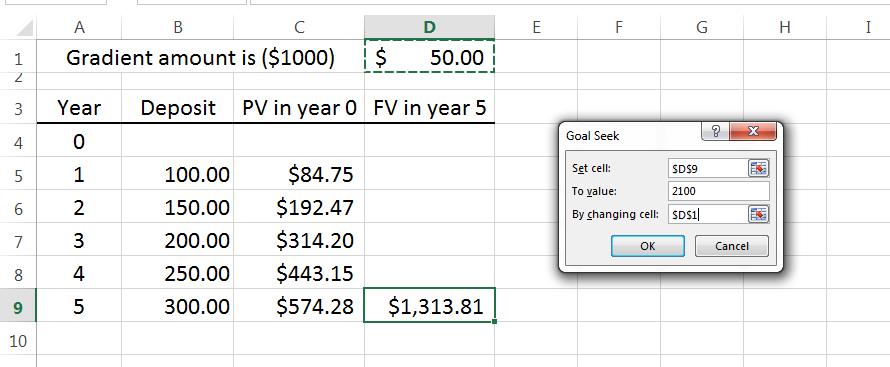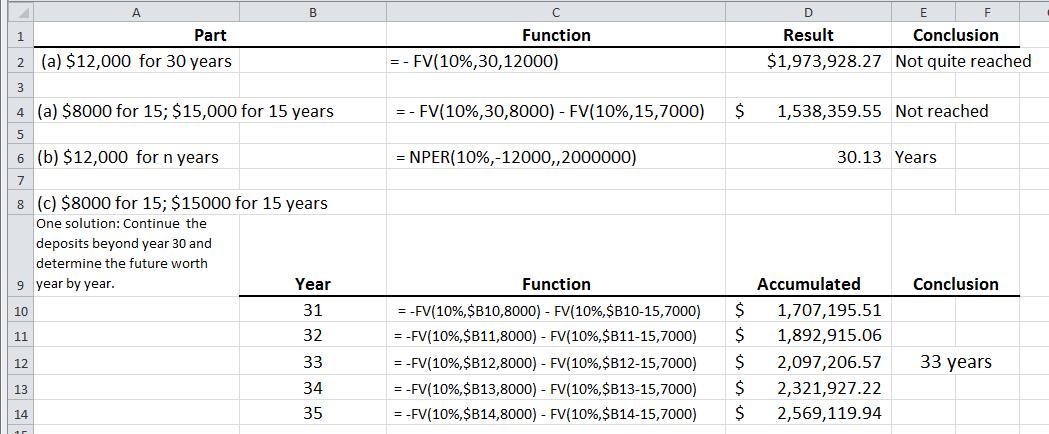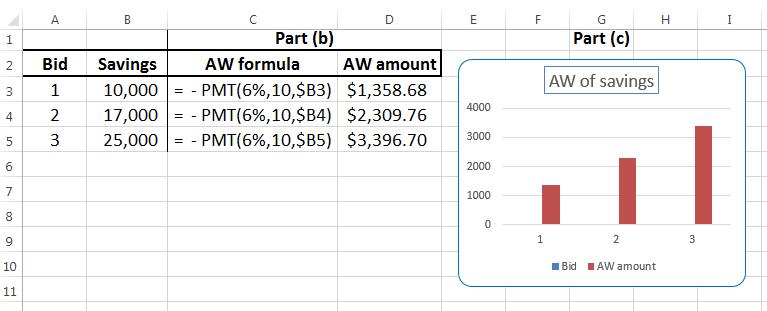Solutions to end-of-chapter problems
Engineering Economy, 8th edition
Leland Blank and Anthony Tarquin
Chapter 2
Factors: How Time and Interest Affect Money
Determination of F, P and A
2.1 (1) (F/P, 10%, 7) = 1.9487
(2) (A/P, 12%,10) = 0.17698
(3) (P/G,15%,20) = 33.5822
(4) (F/A,2%,50) = 84.5794
(5) (A/G,35%,15) = 2.6889
2.2 F = 1,200,000(F/P,7%,4) = 1,200,000(1.3108) = $1,572,960
2.3 F = 200,000(F/P,10%,3) = 200,000(1.3310) = $266,200
2.4 P = 7(120,000)(P/F,10%,2) = 840,000(0.8264) = $694,176
2.5 F = 100,000,000/30(F/A,10%,30) = 3,333,333(164.4940) = $548,313,333
2.6 P = 25,000(P/F,10%,8) = 25,000(0.4665) = $11,662.50
Copyright © 2018 McGraw-Hill Education. All rights reserved. No reproduction or distribution without the prior written consent of McGraw-Hill Education.
2.7 P = 8000(P/A,10%,10) = 8000(6.1446) = $49,156.80
2.8 P = 100,000((P/A,12%,2) = 100,000(1.6901) = $169,010
2.9 F = 12,000(F/A,10%,30) = 12,000(164.4940) = $1,973,928
2.10 A = 50,000,000(A/F,20%,3) = 50,000,000(0.27473) = $13,736,500
2.11 F = 150,000(F/P,18%,5) = 150,000(2.2878) = $343,170
2.12 P = 75(P/F,18%,2) = 75(0.7182) = $53.865 million
2.13 A = 450,000(A/P,10%,3) = 450,000(0.40211) = $180,950
2.14 P = 30,000,000(P/F,10%,5) – 15,000,000 = 30,000,000(0.6209) – 15,000,000 = $3,627,000
2.15 F = 280,000(F/P,12%,2) = 280,000(1.2544) = $351,232
2.16 F = (200 – 90)(F/A,10%,8) = 110(11.4359) = $1,257,949
Copyright © 2018 McGraw-Hill Education. All rights reserved. No reproduction or distribution without the prior written consent of McGraw-Hill Education.
2.17 F = 125,000(F/A,10%,4) = 125,000(4.6410) = $580,125
2.18 F = 600,000(0.04)(F/A,10%,3) = 24,000(3.3100) = $79,440
2.19 P = 90,000(P/A,20%,3) = 90,000(2.1065) = $189,585
2.20 A = 250,000(A/F,9%,5) = 250,000(0.16709) = $41,772.50
2.21 A = 1,150,000(A/P,5%,20) = 1,150,000(0.08024) = $92,276
2.22 P = (110,000* 0.3)(P/A,12%,4) = (33,000)(3.0373) = $100,231
2.23 A = 3,000,000(10)(A/P,8%,10) = 30,000,000(0.14903) = $4,470,900
2.24 A = 50,000(A/F,20%,3) = 50,000(0.27473) = $13,736
Copyright © 2018 McGraw-Hill Education. All rights reserved. No reproduction or distribution without the prior written consent of McGraw-Hill Education.
Factor Values
2.25 (a)
1. Interpolate between i = 8% and i = 9% at n = 15:
0.4/1 = x/(0.3152 – 0.2745)
x = 0.0163
(P/F,8.4%,15) = 0.3152 – 0.0163 = 0.2989
2. Interpolate between i = 16% and i = 18% at n = 10:
1/2 = x/(0.04690 - 0.04251)
x = 0.00220
(A/F,17%,10) = 0.04690 – 0.00220 = 0.04470
(b)
1. (P/F,8.4%,15) = 1/(1 + 0.084)15 = 0.2982
2. (A/F,17%,10) = 0.17/[(1 + 0.17)10 - 1] = 0.04466
(c) 1. = -PV(8.4%,15,,1) displays 0.29824
2. = -PMT(17%,10,,1) displays 0.04466
2.26 (a) 1. Interpolate between i = 18% and i = 20% at n = 20:
1/2 = x/40.06
x = 20.03
(F/A,19%,20) = 146.6280 + 20.03 =166.658
2. Interpolate between i = 25% and i = 30% at n = 15:
1/5 = x/0.5911
x = 0.11822
(P/A,26%,15) = 3.8593 – 0.11822 = 3.7411
(b) 1. (F/A,19%,20) = [(1+ 0.19)20 – 1]/0.19 = 165.418
2. (P/A,26%,15) = [(1 + 0.26)15 –1]/[0.26(1 + 0.26)15] = 3.7261
Copyright © 2018 McGraw-Hill Education. All rights reserved. No reproduction or distribution without the prior written consent of McGraw-Hill Education.
(c) 1. = -FV(19%,20,1) displays 165.41802
2. = -PV(26%,15,1) displays 3.72607
2.27 (a) 1. Interpolate between n = 32 and n = 34:
1/2 = x/78.3345
x = 39.1673
(F/P,18%,33) = 199.6293 + 39.1673 = 238.7966
2. Interpolate between n = 50 and n = 55:
4/5 = x/0.0654
x = 0.05232
(A/G,12%,54) = 8.1597 + 0.05232 = 8.2120
(b) 1. (F/P,18%,33) = (1+0.18)33 = 235.5625
2. (A/G,12%,54) = {(1/0.12) – 54/(1+0.12)54 –1} = 8.2143
2.28 Interpolated value: Interpolate between n = 40 and n = 45:
3/5 = x/(72.8905 – 45.2593)
x = 16.5787
(F/P,10%,43) = 45.2593 + 16.5787 = 61.8380
Formula value: (F/P,10%,43) = (1+ 0.10)43 = 60.2401
% difference = [(61.8380 - 60.2401)/ 60.2401]*100 = 2.65%
Arithmetic Gradient
2.29 (a) G = $-300 (b) CF5 = $2800 (c) n = 9
Copyright © 2018 McGraw-Hill Education. All rights reserved. No reproduction or distribution without the prior written consent of McGraw-Hill Education.
2.30 P0 = 500(P/A,10%,9) + 100(P/G,10%,9) = 500(5.7590) + 100(19.4215) = 2879.50 + 1942.15 = $4821.65
2.31 (a) Revenue = 390,000 + 2(15,000) = $420,000
(b) A = 390,000 + 15,000(A/G,10%,5) = 390,000 + 15,000(1.8101) = $417,151.50
2.32 A = 9000 – 560(A/G,10%,5) = 9000 – 560(1.8101) = $7986
2.33 500 = 200 + G(A/G,10%.7)
500 = 200 + G(2.6216)
G = $114.43
2.34 A = 100,000 + 10,000(A/G,10%,5) = 100,000 + 10,000(1.8101) = $118,101
F = 118,101(F/A,10%,5) = 118,101(6.1051) = $721,018
2.35 3500 = A + 40(A/G,10%,9)
3500 = A + 40(3.3724)
A = $3365.10
2.36 In $ billion units, P = 2.1(P/F,18%,5) = 2.1(0.4371) = 0.91791 = $917,910,000
Copyright © 2018 McGraw-Hill Education. All rights reserved. No reproduction or distribution without the prior written consent of McGraw-Hill Education.
917,910,000 = 100,000,000(P/A,18%,5) + G(P/G,18%,5)
917,910,000 = 100,000,000(3.1272) + G(5.2312)
G = $115,688,561
2.37 95,000 = 55,000 + G(A/G,10%,5)
95,000 = 55,000 + G(1.8101)
G = $22,098
2.38 P in year 0 = 500,000(P/F,10%,10) = 500,000(0.3855) = $192,750
192,750 = A + 3000(P/G,10%,10)
192,750 = A + 3000(22.8913)
A = $124,076
Geometric Gradient
2.39 Find (P/A,g,i,n) using Equation [2.32] and A1 = 1
For n = 1: P g = 1*{1 – [(1 + 0.05)/(1 + 0.10)]1}/(0.10 – 0.05) = 0.90909
For n = 2: P g = 1*{1 – [(1 + 0.05)/(1 + 0.10)]2}/(0.10 – 0.05) = 1.77686
2.40 Decrease deposit in year 4 by 7% per year for three years to get back to year 1. First deposit = 5550/(1 + 0.07)3 = $4530.45
2.41 P g = 35,000{1 – [(1 + 0.05)/(1 + 0.10)]6}/(0.10 – 0.05) = $170,486
2.42 P g = 200,000{1 – [(1 + 0.03)/(1 + 0.10)]5}/(0.10 – 0.03) = $800,520
Copyright © 2018 McGraw-Hill Education. All rights reserved. No reproduction or distribution without the prior written consent of McGraw-Hill Education.
2.43 First find P g and then convert to F in year 15
P g = (0.10)(160,000){1 – [(1 + 0.03)/(1 + 0.07)]15/(0.07 – 0.03)} = 16,000(10.883) = $174,128.36
F = 174,128.36(F/P,7%,15) = 174,128.36 (2.7590) = $480,420.15
2.44 (a) Pg = 260{1 – [(1 + 0.04)/(1 + 0.06)]20}/(0.06 – 0.04) = 260(15.8399) = $4119.37
(b) PTotal = (4119.37)(51,000) =$210,087,870
2.45 Solve for P g in geometric gradient equation and then convert to A
A1 = 5,000,000(0.01) = 50,000
P g = 50,000[1 – (1.10/1.08)5]/(0.08 – 0.10) = $240,215
A = 240,215(A/P,8%,5) = 240,215(0.25046) = $60,164
2.46 First find P g and then convert to F
P g = 5000[1 – (0.95/1.08)5]/(0.08 + 0.05) = $18,207
F = 18,207(F/P,8%,5) = 18,207(1.4693) = $26,751
Copyright © 2018 McGraw-Hill Education. All rights reserved. No reproduction or distribution without the prior written consent of McGraw-Hill Education.
Interest Rate and Rate of Return
2.47 1,000,000 = 290,000(P/A,i,5)
(P/A,i,5) = 3.44828
Interpolate between 12% and 14% interest tables or use Excel’s RATE function
By RATE, i = 13.8%
2.48 50,000 = 10,000(F/P,i,17)
5.0000 = (F/P,i,17)
5.0000 = (1 + i)17
i = 9.93%
2.49 F = A(F/A,i%,5)
451,000 = 40,000(F/A,i%,5)
(F/A,i%,5) = 11.2750
Interpolate between 40% and 50% interest tables or use Excel’s RATE function
By RATE, i = 41.6%
2.50 Bonus/year = 6(3000)/0.05 = $360,000
1,200,000 = 360,000(P/A,i,10)
(P/A,i,10) = 3.3333
i = 27.3%
2.51 Set future values equal to each other
Simple: F = P + Pni = P(1 + 5*0.15) = 1.75P
Compound: F = P(1 + i)n = P(1 + i)5
1.75P = P(1 + i)5
i = 11.84%
2.52 100,000 = 190,325(P/F,i,30)
(P/F,i,30) = 0.52542
Find i by interpolation between 2% and 3%, or by solving P/F equation, or by Excel
By RATE function, i = 2.17%
© 2018
2.53 400,000 = 320,000 + 50,000(A/G,i,5)
(A/G,i,5) = 1.6000
Interpolate between i = 22% and i = 24% i = 22.6%
Number of Years
2.54 160,000 = 30,000(P/A,15%,n)
(P/A,15%,n) = 5.3333
From 15% table, n is between 11 and 12 years; therefore, n = 12 years
By NPER, n = 11.5 years
2.55 (a) 2,000,000 = 100,000(P/A,5%,n)
(P/A,5%,n) = 20.000
From 5% table, n is > 100 years. In fact, at 5% per year, her account earns $100,000 per year. Therefore, she will be able to withdraw $100,000 forever; actually, n is ∞.
(b) 2,000,000 = 150,000(P/A,5%,n)
(P/A,5%,n) = 13.333
By NPER, n = 22.5 years
(c) The reduction is impressive from forever (n is infinity) to n = 22.5 years for a 50% increase in annual withdrawal. It is important to know how much can be withdrawn annually when a fixed amount and a specific rate of return are involved.
2.56 10A = A(F/A,10%,n)
(F/A,10%,n) = 10.000
From 10% factor table, n is between 7 and 8 years; therefore, n = 8 years
2.57 (a) 500,000 = 85,000(P/A,10%,n)
(P/A,10%,n) = 5.8824
From 10% table, n is between 9 and 10 years
(b) Using the function = NPER(10%,-85000,500000), the displayed n = 9.3 years.
Copyright © 2018 McGraw-Hill Education. All rights reserved. No reproduction or distribution without the prior written consent of McGraw-Hill Education.
2.58 1,500,000 = 6,000,000(P/F,25%,n)
(P/F,25%,n) = 0.2500
From 25% table, n is between 6 and 7 years; therefore, n = 7 years
2.59 15,000 = 3000 + 2000(A/G,10%,n)
(A/G,10%,n) = 6.0000
From 10% table, n is between 17 and 18 years; therefore, n = 18 years. She is not correct; it takes longer.
2.60 First set up equation to find present worth of $2,000,000 and set that equal to P in the geometric gradient equation. Then, solve for n.
P = 2,000,000(P/F,7%,n)
2,000,000(P/F,7%,n) = 10,000{1 – [(1+0.10)/(1+0.07)]n}/(0.07 – 0.10)
Solve for n using Goal Seek or trial and error. By trial and error, n = is between 25 and 26; therefore, n = 26 years
Exercises for Spreadsheets
2.61
a = -FV(10%,30,100000000/30)
b = -FV(10%,33,100000000/30)
$548,313,409
$740,838,481
c = -FV(10%,33,100000000/30) + FV(10%,3,(100000000/30)*2) $718,771,814
2.63 Goal Seek template before and result after with solution for G = $115.69 million



2.64 Here is one approach to the solution using NPV and FV functions with results (left) and formulas (right).
Year,
Present worth
= $A3+1 10000 =NPV(7%,$B$4:$B4) = -FV(7%,$A4,,$C4)
= $A4+1 = $B4*1.1 =NPV(7%,$B$4:$B5) = -FV(7%,$A5,,$C5)
= $A5+1 = $B5*1.1 =NPV(7%,$B$4:$B6) = -FV(7%,$A6,,$C6)
= $A6+1 = $B6*1.1 =NPV(7%,$B$4:$B7) = -FV(7%,$A7,,$C7)
= $A7+1 = $B7*1.1 =NPV(7%,$B$4:$B8) = -FV(7%,$A8,,$C8)
= $A8+1 = $B8*1.1 =NPV(7%,$B$4:$B9) = -FV(7%,$A9,,$C9)
= $A9+1 = $B9*1.1 =NPV(7%,$B$4:$B10) = -FV(7%,$A10,,$C10)
= $A10+1 = $B10*1.1 =NPV(7%,$B$4:$B11) = -FV(7%,$A11,,$C11)
= $A11+1 = $B11*1.1 =NPV(7%,$B$4:$B12) = -FV(7%,$A12,,$C12)
= $A12+1 = $B12*1.1 =NPV(7%,$B$4:$B13) = -FV(7%,$A13,,$C13)
= $A13+1 = $B13*1.1 =NPV(7%,$B$4:$B14) = -FV(7%,$A14,,$C14)
= $A14+1 = $B14*1.1 =NPV(7%,$B$4:$B15) = -FV(7%,$A15,,$C15)
= $A15+1 = $B15*1.1 =NPV(7%,$B$4:$B16) = -FV(7%,$A16,,$C16)
= $A16+1 = $B16*1.1 =NPV(7%,$B$4:$B17) = -FV(7%,$A17,,$C17)
= $A17+1 = $B17*1.1 =NPV(7%,$B$4:$B18) = -FV(7%,$A18,,$C18)
= $A18+1 = $B18*1.1 =NPV(7%,$B$4:$B19) = -FV(7%,$A19,,$C19)
= $A19+1 = $B19*1.1 =NPV(7%,$B$4:$B20) = -FV(7%,$A20,,$C20)
= $A20+1 = $B20*1.1 =NPV(7%,$B$4:$B21) = -FV(7%,$A21,,$C21)
= $A21+1 = $B21*1.1 =NPV(7%,$B$4:$B22) = -FV(7%,$A22,,$C22)
= $A22+1 = $B22*1.1 =NPV(7%,$B$4:$B23) = -FV(7%,$A23,,$C23)
= $A23+1 = $B23*1.1 =NPV(7%,$B$4:$B24) = -FV(7%,$A24,,$C24)
= $A24+1 = $B24*1.1 =NPV(7%,$B$4:$B25) = -FV(7%,$A25,,$C25)
= $A25+1 = $B25*1.1 =NPV(7%,$B$4:$B26) = -FV(7%,$A26,,$C26)
= $A26+1 = $B26*1.1 =NPV(7%,$B$4:$B27) = -FV(7%,$A27,,$C27)
= $A27+1 = $B27*1.1 =NPV(7%,$B$4:$B28) = -FV(7%,$A28,,$C28)
= $A28+1 = $B28*1.1 =NPV(7%,$B$4:$B29) = -FV(7%,$A29,,$C29)
= $A29+1 = $B29*1.1 =NPV(7%,$B$4:$B30) = -FV(7%,$A30,,$C30)
= $A30+1 = $B30*1.1 =NPV(7%,$B$4:$B31) = -FV(7%,$A31,,$C31)
= $A31+1 = $B31*1.1 =NPV(7%,$B$4:$B32) = -FV(7%,$A32,,$C32)
= $A32+1 = $B32*1.1 =NPV(7%,$B$4:$B33) = -FV(7%,$A33,,$C33)
Copyright © 2018 McGraw-Hill Education. All rights reserved. No reproduction or distribution without the prior written consent of McGraw-Hill Education.
2.65 (a) Present worth is the value of the savings for each bid
Bid 1: Savings = $10,000
Bid 2: Savings = $17,000
Bid 3: Savings = $25,000
(b) and (c) Spreadsheet for A values and column chart

ADDITIONAL PROBLEMS AND FE REVIEW QUESTIONS
2.66 Answer is (a)
2.67 P = 840,000(P/F,10%,2) = 840,000(0.8264) = $694,176
Answer is (a)
2.68 P = 81,000(P/F,6%,4) = 81,000(0.7921) = $64,160 Answer is (d)
2.69 F = 25,000(F/P,10%,25) = 25,000(10.8347) = $270,868
Answer is (c)
2.70 A = 10,000,000(A/F,10%,5) = 10,000,000(0.16380) = $1,638,000
Answer is (a)
Copyright © 2018 McGraw-Hill Education. All rights reserved. No reproduction or distribution without the prior written consent of McGraw-Hill Education.
2.71 A = 2,000,000(A/F,8%,30) = 2,000,000(0.00883) = $17,660
Answer is (a)
2.72 390 = 585(P/F,i,5)
(P/F,i,5) = 0.6667
From tables, i is between 8% and 9%
Answer is (c)
2.73 AW = 26,000 + 1500(A/G,8%,5) = $28,770
Answer is (b)
2.74 30,000 = 4202(P/A,8%,n)
(P/A,8%,5) = 7.1395
n = 11 years
Answer is (d)
2.75 23,632 = 3000{1- [(1+0.04)n/(1+0.06)n]}/(0.06-0.04)
[(23,632*0.02)/3000]-1 = (0.98113)n
log 0.84245 = nlog 0.98113
n = 9
Answer is (b)
2.76 A = 800 – 100(A/G,8%,6) = 800 – 100(2.2763) = $572.37
Answer is (c)
2.77 P = 100,000(P/A,10%,5) - 5000(P/G,10%,5) = 100,000(3.7908) - 5000(6.8618) = $344,771
Answer is (a)
2.78 109.355 = 7(P/A,i,25)
(P/A,i,25) = 15.6221
Copyright © 2018 McGraw-Hill Education. All rights reserved. No reproduction or distribution without the prior written consent of McGraw-Hill Education.
From tables, i = 4%
Answer is (a)
2.79 28,800 = 7000(P/A,10%,5) + G(P/G,10%,5)
28,800 = 7000(3.7908) + G(6.8618)
G = $330
Answer is (d)
2.80 40,000 = 11,096(P/A,i,5)
(P/A,i,5) = 3.6049
i = 12 %
Answer is (c)
Copyright © 2018 McGraw-Hill Education. All rights reserved. No reproduction or distribution without the prior written consent of McGraw-Hill Education.

